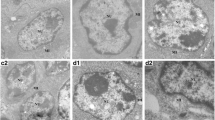Abstract
The Kaschin-Beck Disease, an endemic disease in China, occurs in low-selenium areas. Using human embrionic cartilage cell as a system, the effect of selenite and another etiological factors, such as, organic matters in water, and grain from disease regions, were studied. It was shown that Se(IV), as well as superoxide dismutase, could prevent the cells from damage by organic matters, and increase the activity of GSHpx and decrease the production of lipid peroxide. A model test of adrenalin autooxidation was carried out, and it was found that the oxy-radical can be elminated by Se(IV). Thus, it was assumed, that selenium was a protective factor and free radical scavenger for Kaschin-Beck Disease.
Similar content being viewed by others
References
L. Sokoloff,Clin. Rheum. Dis. 11: 187–202 (1985).
D. X. Mo,Selenium in Biology and Medicine, 3rd Symposium, G. F. Combs et. al. eds., Van Nostrand Reinhold, New York, 1987, pp. 924–933.
O. A. Levander,AIN Symposium proceedings Nutrition '87, O. A. Levander, ed., American Inst. Nutr., Beltsville, 1987, 60.
L. F. Lin,The Collected Works of Sci. Invest. on Kaschin-Beck Disease in Yongshou County, (1979–1982), Publishing House on People's Health, Beijing, 1984, pp. 115, 116.
J. B. Yang,Circum. of Harbin Med. Univ. (Supplementary Issue), 1981, pp. 1–7.
A. Peng and L. Q. Xu,Scientia Sinica, (Series B),30, 66–74 (1987).
A. Peng, Y. J. Wang, W. H. Wang, L. Q. Xu, C. L. Yang,ACTA Scientiae Circumstantiae 7, 240 (1987).
W. Z. Wang, B. N. Chen, and Y. J. Qiao,Chinese Journal of Endemiology 2, 231–234 (1987).
B. L. Fletcher, C. J. Dillard, and A. L. Tappel,Anal. Biochem. 52, 1–9 (1973).
D. G. Hafeman,Jour. Nutr. 104, 580–587 (1974).
A. Peng, C. L. Yang, R. G. He, and D. H. Wang,Environ. Chem. 7, 10–15 (1988).
A. Peng, C. L. Yang, R. G. He, and D. H. Wang,Acta. Scientia Circumstantiae 9, 292–300 (1989).
P. H. Misra and I. Fridovilh,Jour. Biol. Chem. 10, 8170–8174 (1972).
P. Biemond, A. J. G. Swaak, H. G. van Eijk, and J. F. Koster,Free Radical Biology and Medicine 4, 185–198 (1988).
Author information
Authors and Affiliations
Rights and permissions
About this article
Cite this article
Peng, A., Yang, C.L. Examination of the roles of selenium in the Kaschin-Beck Disease. Biol Trace Elem Res 28, 1–9 (1991). https://doi.org/10.1007/BF02990457
Received:
Accepted:
Issue Date:
DOI: https://doi.org/10.1007/BF02990457




